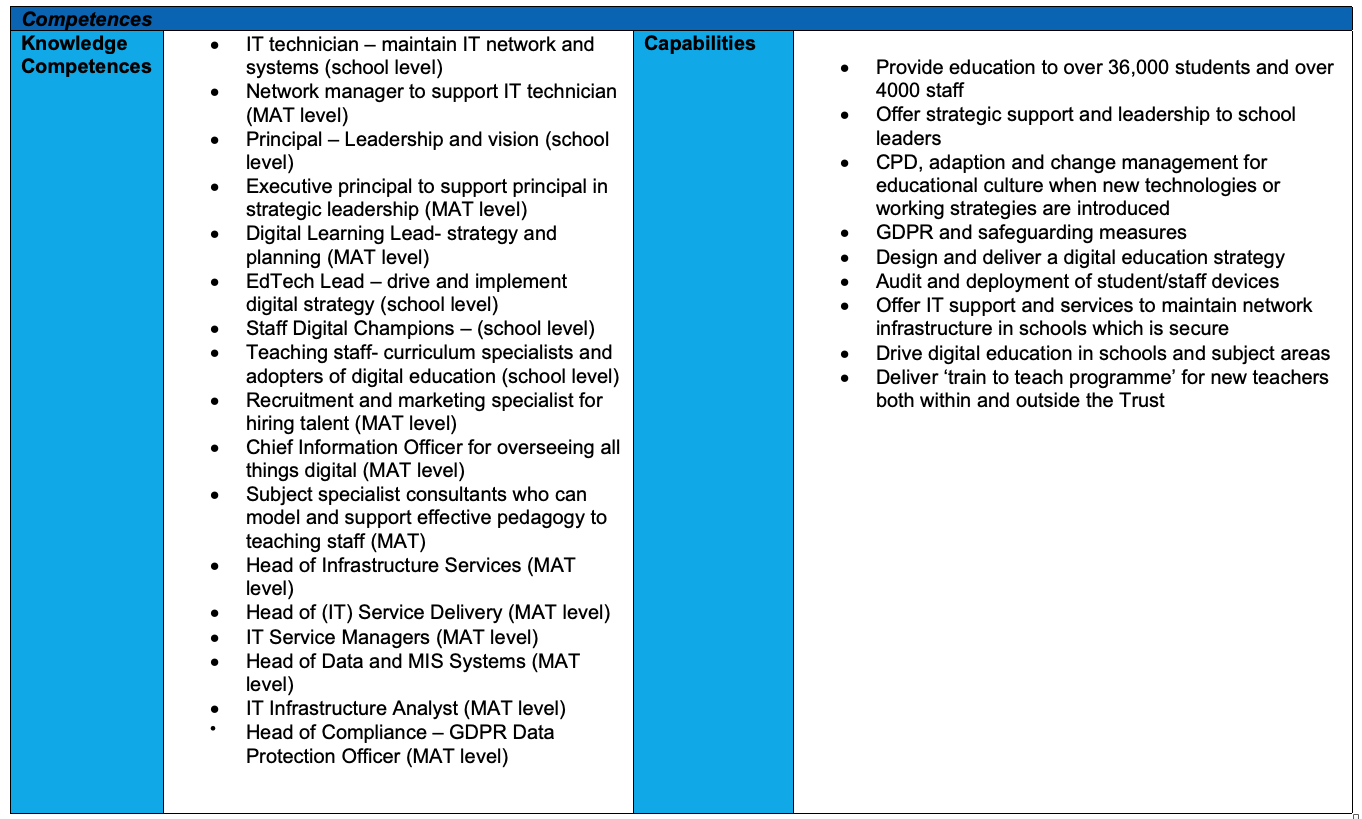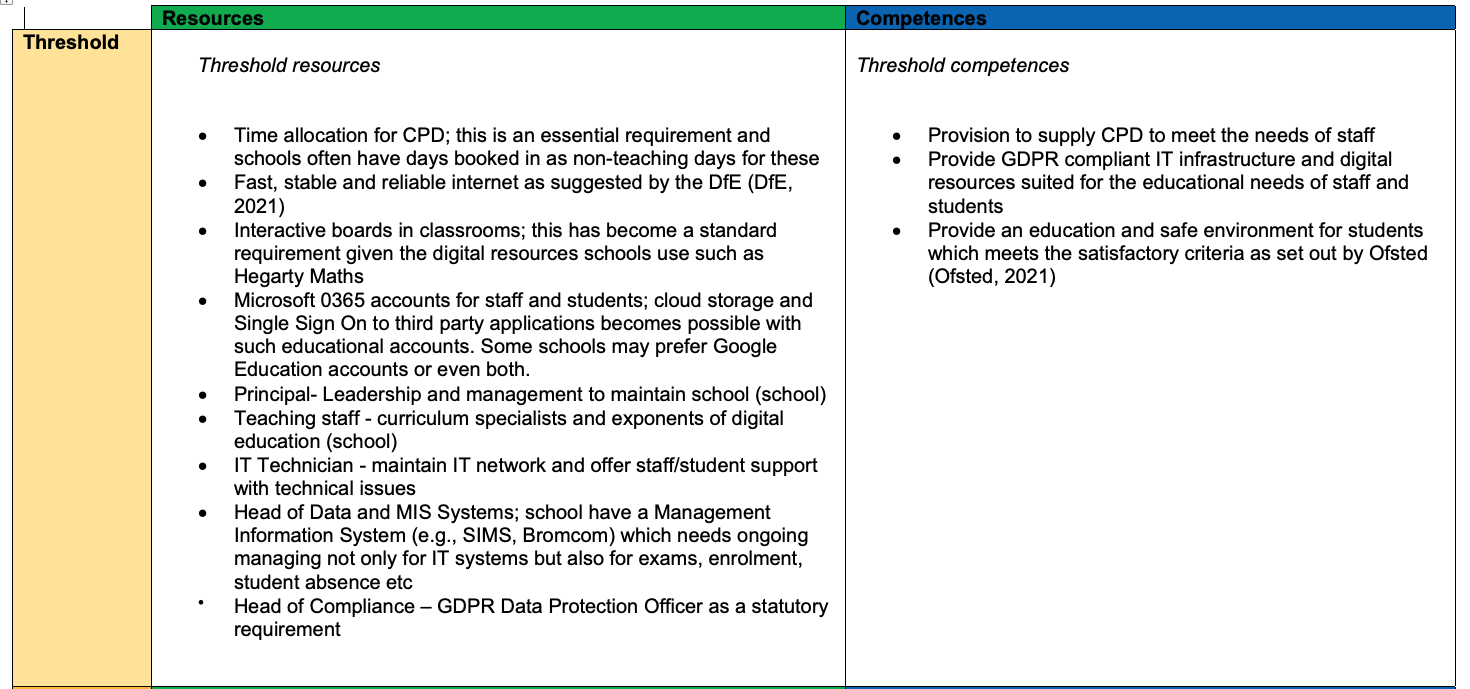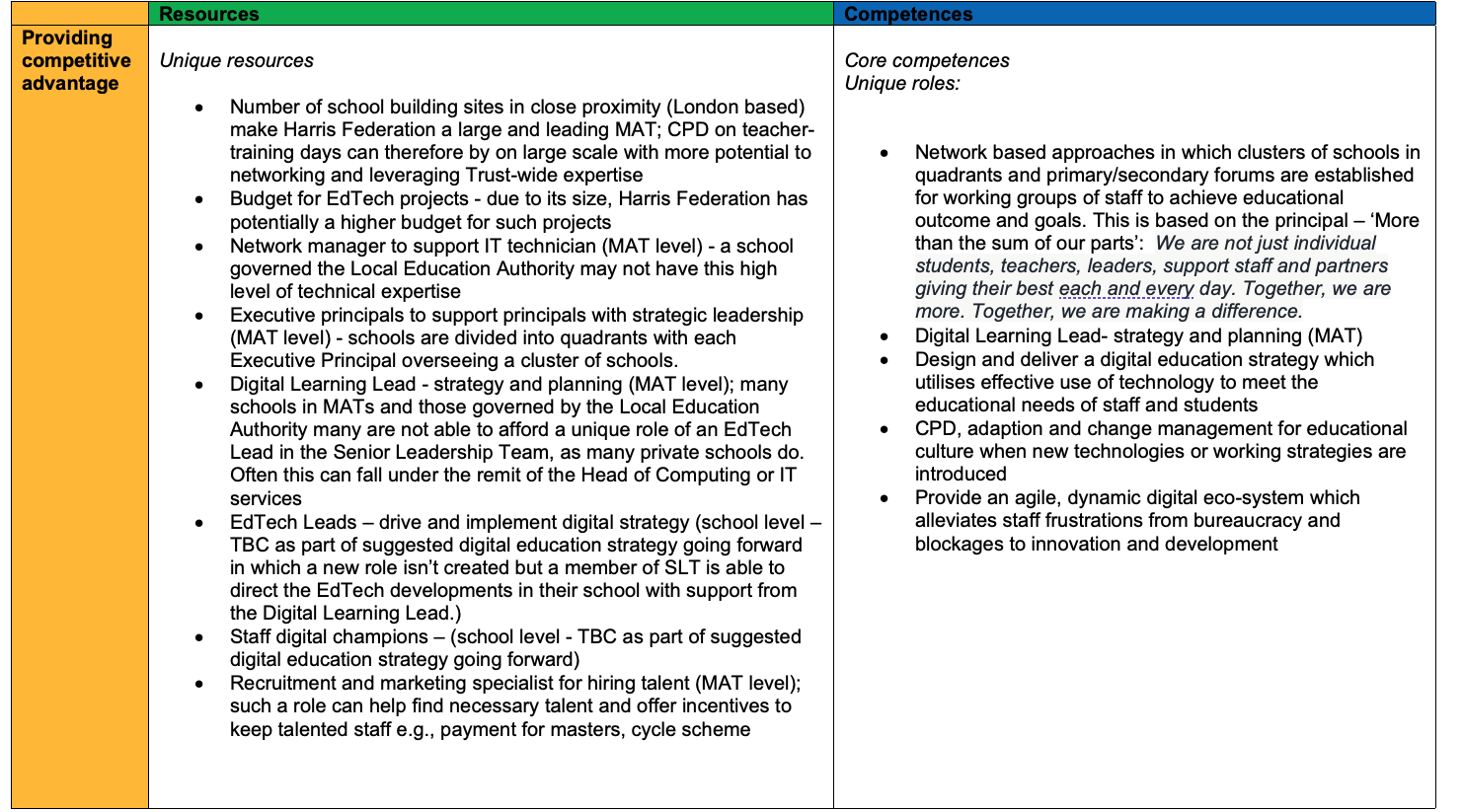The ELPS resources and competencies document was completed based on delivering a digital education strategy for a school within a Multi-Academy Trust – the resources and competencies are influenced not only by the relationship between a school and Head Office but also by other schools in the Trust.





Rather than take a view of the whole MAT operating across all fifty schools, it seemed more practical for this task to consider resources at a local school level within a MAT as most of the tangible/intangible resources are acquired at the school level through their given autonomy with support from the Trust. I found the exercise offered an interesting perspective of threshold vs unique resources and correlates quite well with some of the tangible resources work I am currently doing with schools; there are issues around staff time for CPD, funding for digital resources and outdated IT infrastructure – a situation well recognised a national issue (DfE, 2021). Although the task is around resources a key factor in their effective deployment and use is culture and beliefs on EdTech (Cacciamani et al., 2018); this currently is not an essential requirement for schools given the Ofsted framework (Ofsted, 2021) nor is the Trust at a point of demonstrating this as a resource which provides them with a competitive advantage and therefore was not identified explicitly in the provided table. Digital resources such as Learning by Questions, Century Tech, are seen as teaching or homework aids and are not currently critically evaluated for meaningful impact using a framework such as SAMR or TPACK. Currently, the major competitive advantage Harris Federation has is that it has only taken on schools in close proximity to each other – all are in London, unlike some other multi-academy Trusts. They can therefore afford annual CPD sessions twice a year in Excel, London, to share good practice etc. ‘We are more the sum of our parts’ is built into the ethos of the Trust; so even if all engagement between schools was to take place online, having a strategy in which Trust-wide expertise can be leveraged would provide the competitive advantage. New roles such as the Chief Information Officer and Digital Learning Lead have been created to resolve existing IT issues, develop the infrastructure and ensure it meets the needs of staff and students in the 21st century. Some MAT may not have a CIO to oversee different areas from MIS, Data Protection, Security, HR systems to IT Support Services and ensure they communicate effectively with each other for optimised workflow; in the absence of such a role, you would have disintegrated systems leading to backlogs due to high levels of bureaucracy and lack of efficient systems. The Digital Learning Lead role has come to the forefront during the pandemic when schools were required to deliver remote learning; often MATs may rely on Microsoft, Google or DfE Demonstrator School partners to deliver training but this doesn’t necessarily translate into meaningful uptake or embedding into the culture unless there is the drive from the senior leadership with a clear vision and strategic plan of EdTech in a school, which is precisely the role of the Digital Learning Lead. In schools you also need roles such as curriculum specialist Digital Champions who can act as catalysts to change and adoption as well as an EdTech Lead (SLT member) on the ground, to drive the EdTech in the school based on the strategic direction given by Digital Learning Lead.
References
Cacciamani, S. et al. (2018) ‘Factors Affecting Students’ Acceptance of Tablet PCs: A Study in Italian High Schools’, Journal of Research on Technology in Education, 50(2), pp. 120–133. doi:10.1080/15391523.2017.1409672.
DfE (2021) Realising the potential of technology in education: A strategy for education providers and the technology industry. Available at: https://eu01.alma.exlibrisgroup.com/leganto/readinglist/citation/32197485640002466?institute=44UOE_INST&auth=SAML (Accessed: 31 October 2021).
Ofsted (2021) School inspection handbook, GOV.UK. Available at: https://www.gov.uk/government/publications/school-inspection-handbook-eif/school-inspection-handbook (Accessed: 20 November 2021).




Effective deployment and use is culture and beliefs on EdTech are very novel Intangible resource. This is very consistent with two old Chinese sayings. “(君子)善假于物也” Good people are good with external objects。“故非有志者不能至” People without belief can’t get there
While I understand the rationale for focusing on a single school, there is an interesting question on identifying what value the MAT generates for that schools. The academic Andrew Campbell referred to this as the parenting advantage – see https://www.valuebasedmanagement.net/methods_parenting_advantage.html – of course, this conceptualisation would need a hefty amount of translation for a school and MAT context although you do start to do that with the Harris Trust.
The point about culture is well made. I’m a bit surprised that this is not a feature of the Ofsted framework, but do you think parents may be more attuned to the cultures of schools and so it confers competitive advantage through pupil applications(?). The identification of joint CPD as a valuable benefit is useful. Digital resources tend not to be differentiators as they would be available to other schools but how these resources are used could be.
Just to note that the grid you’ve uploaded is a blank one.
Hi Pete
I have updated the post with the correct link and have also now pasted a table too. The school resources are discussed within a MAT context as the two work interdependently.
Thanks for the update. The table is helpful but needs some refinement especially in terms of the detail of the threshold capabilities – what is it about a having a CIO that confers a competitive advantage (especially as a CIO is identified as a threshold competence too)? The does seem to be a clear differentiator in terms of the leadership focus on the digital and the investment in posts – including the subject specialists – equipment and infrastructures, and the relationship with MS.
Thanks, Pete – noted, corrected and updated. Hope it’s clear now – I have updated the table and also written some more in the post.
Thanks for this Saqib, it’s really interesting to see this. Your unique resources are interesting; do you think that some of the material goods (docking stations etc.) provide you with a unique edge, or is it the way these are used that offers this? A lot of institutions are investing in upgraded tech (maybe to support work from home and hot desking when staff return?) and so I wonder if actually the technology isn’t the unique resource but rather the way it is deployed? I also think the roles that exist are very interesting (co-ordinator, champions); how do these connect and interact with one another, and do those interactions themselves also produce a unique resource?
Thanks, Hizfah
V good point about IT resources vs the way they are actually used. Schools vary in their IT infrastructure – which currently isn’t great in the Federation. The docking station approach was really based on 1-1 devices as a strategic model for future development. Re effective use of IT, hopefully, that’s where Digital Education strategy will come in
I have listed the relationship between the Harris Federation subject consultants and their coordinators below.
Hi again. Do you think that the network of schools also create a community of practice? And would you consider this a unique resource? Whilst I appreciate that communities of practice are in themselves not unique, maybe the knowledge that is produced within your particular one does create knowledge that presents a unique resource?
Hi Hifzah
I think the community aspect is in respect to the Harris Federation being the largest MAT in the UK who hold two annual events each year where all the teaching staff come together. Also, schools are all within London. Other MATS are either not as big and may have schools dispersed nationally. The community of practice, from what I have seen so far, is a good one in that the Federation has subject consultants who go in and support schools; each school has a subject coordinator who works with the consultant. There are regular online meetings to offer curriculum support.
In other schools/MATS I have worked in, the community (if there is one) may not be led by a subject consultant or staff may be part of external communities outside the Trust and therefore may not have the advantage of the cultural context of their Trust and colleagues. Example of external communities include: Microsoft Innovative Educator community, or eLearning roundtable etc
This is an interesting post for me as it offers insight into an area of education I am not familiar with. Some of the issues you mention (CPD staff time, digital resourcing capabilities, dated infrastructure) are also relevant to the higher education sector, though. Your point on certain digital resources as not currently evaluated for meaningful impact using well-known frameworks is interesting. What, then, are the criterial currently used for evaluation?
Hi
In the absence of a digital education strategy, schools are simply provided devices from the DfE or purchased in order for IT to work in and out of the classroom. More digital mature schools may use Microsoft or Google based criteria to become a showcase school and learn about good practice from other schools in that network. What’s your experience?
Saqib